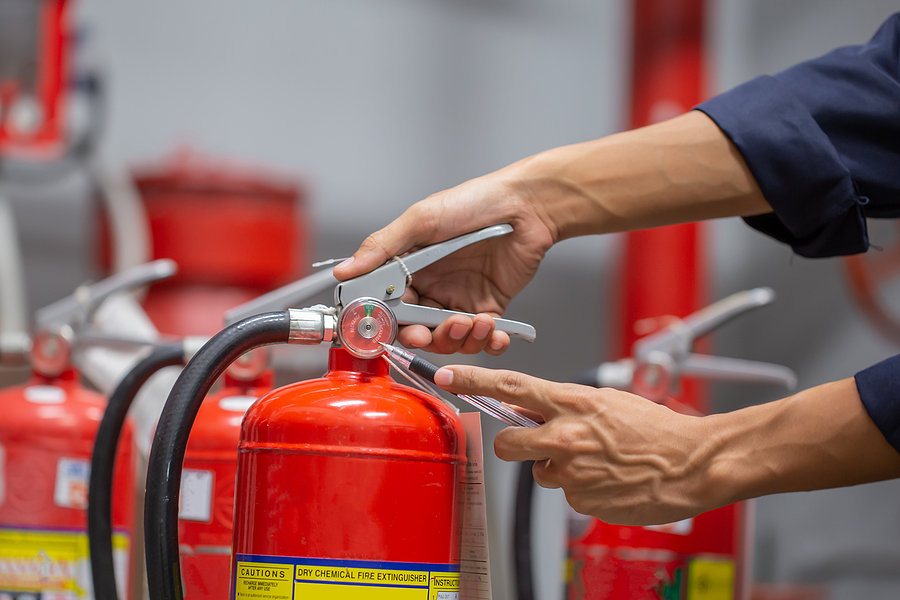Having functional, readily accessible fire extinguishers is an essential fire safety measure for any business. When a fire breaks out in your New Mexico premises, you will reach for the nearest extinguisher to suppress the flames in their early stages.
For this reason, it is critical that all your fire extinguishers are in good working order through proper inspections. With routine checks, you can rest assured that your extinguishers are in prime condition and ready for use when an emergency strikes.
There are many types of fire extinguishers available.
Each extinguisher type requires specific examination to guarantee they can serve their intended purpose when disaster hits unexpectedly. For extinguisher inspections to be effective, they must cover installation, record keeping, and maintenance tests.
Proper fire extinguisher checks can mean the difference between life and death when a fire occurs.
Why Fire Extinguisher Inspections Are Crucial
Though the likelihood of ever needing to use a fire extinguisher is low, inspecting them is still essential because emergencies can happen without warning. The worst-case scenario is trying to put out a fire with a faulty extinguisher, posing serious dangers to everyone involved.
Without your knowledge, extinguishers can become damaged over time. Inspections ensure there are no issues with outdated or malfunctioning components when you need them most.
One of the most important goals of inspections is ensuring extinguishers are located where they are strategically intended to be. Many employees in your workplace may not know where the nearest extinguisher is, which can be problematic in an emergency.
Inspectors give you the chance to learn about this element and demonstrate where one can be accessed immediately if necessary. They will check that extinguishers are mounted in proper brackets to prevent slipping off walls and sustaining damage.
Step-by-Step Fire Extinguisher Inspection Process
Step 1 – Inspect Exterior Components
First, ensure all exterior components on the extinguisher are visible and intact before moving to the next phase of inspection. This preliminary check should include the handle, safety pin/tamper tag, nozzle, hose, and inspection tag. Without all these parts functioning properly, fire extinguisher inspections are pointless when hazardous situations arise.
Step 2 – Examine Tags
An inspection/maintenance tag should be attached to each extinguisher. This inspection method is vital for confirming your extinguisher has been properly examined within the current month and determining if it has had a recent checkup. These tags are essential for record keeping of key details about your extinguisher. The serial/model number, expiration date, and condition of the extinguisher are crucial pieces of info that should be included on the tags to meet NFPA standards.
Step 3 – Inspect Pressure Gauge
Your fire extinguisher inspection gauge should always be pointing towards the green zone. Green indicates “good to go,” so remember “green means go” when recalling this. The needle in the green means the extinguisher is fully pressurized and prepared to work correctly in an emergency. If the gauge is pointing towards any red zones, the extinguisher needs to be recharged or replaced immediately. Never try using an extinguisher with a red indicator light showing. It won’t function properly and poses serious public safety hazards wherever you attempt to use it.
Step 4 – Verify Safety Pin is Intact
Every fire extinguisher has a safety pin in place to prevent accidental discharge during inspection. Some extinguishers, depending on make and model, feature a plastic tamper seal to prevent the pin from coming out unintentionally. Missing pins and accidental discharge can quickly envelop an area in a white cloud. The safety pin is a crucial component in extinguisher inspections to ensure this equipment remains safe, as this can create a major hazard for everyone nearby.
Step 5 – Check Extinguisher is Full
This is one of the most important steps, since without it the others are meaningless. You can confirm the extinguisher is full by picking it up and feeling the weight of the internal agent. If done properly, you should feel the agent sloshing side to side. If you cannot feel it moving during this process, the extinguisher is either empty or expired. This simple step will allow you to determine if your unit just needs recharging or replacing.
Step 6 – Look for Damage and Dents
Continuing from step one, this step looks closer at the extinguisher’s exterior. Dents, punctures, rust, or any other visible physical damage can become major issues when you go to utilize your extinguisher. Even minor dents or rust indicators may render a fire extinguisher ineffective in an emergency.
Like an old tire past its prime, fire extinguishers can slowly leak over time. These leaks cause depressurization and discharge of the gas. While the gas leak itself may not endanger those nearby, it can make the fire extinguisher unusable. An extinguisher with depressurization will be impossible to use for certain fires like kitchen grease that cannot be extinguished with water, putting everyone at risk.
Step 7 – Inspect Fire Extinguisher Hose
Fire extinguisher inspections are fruitless if the hose isn’t in good working order. Kinks, cracks, cylinder attachment issues, and breakage can all cause defective hoses that prevent extinguisher agent from moving up the line. Check inside the hose while examining it for any clogs or blockages that might impede operation. If the hose has clear issues as described, you will need to have it replaced or in severe cases, the entire extinguisher.
Step 8 – Verify Instructions and Documentation are Legible
The fire extinguisher instructions should always be readable and clear on the surface. If these instructions are torn or missing key details, it is time to replace the extinguisher. Never try making your own instructions as doing so may violate building codes and jeopardize the safety of everyone using the equipment.
Always remember to document your inspection on the provided tag once fully completed. This will make it easier on future inspections to determine when the last one was done and if everything is as up to date.
